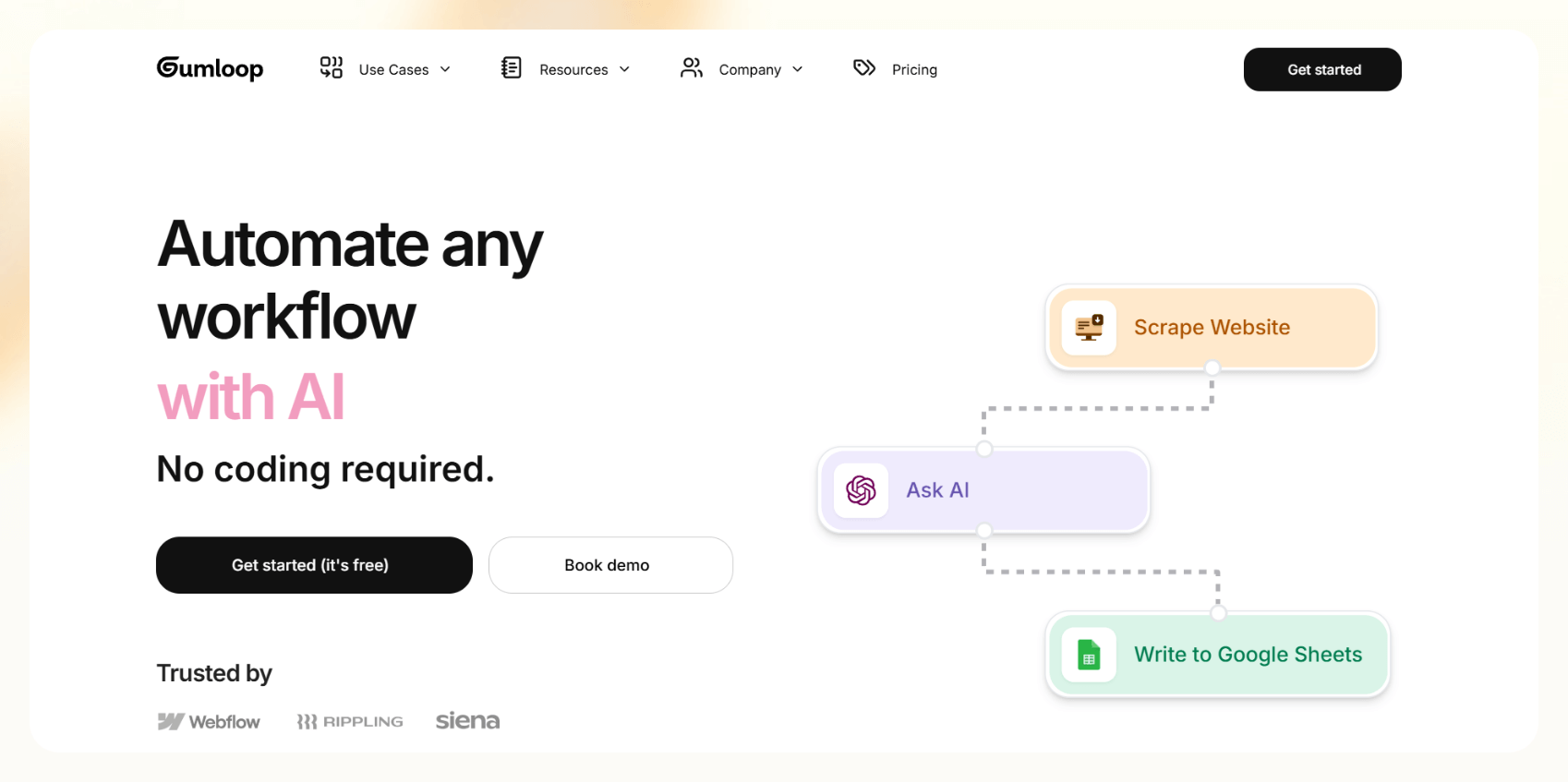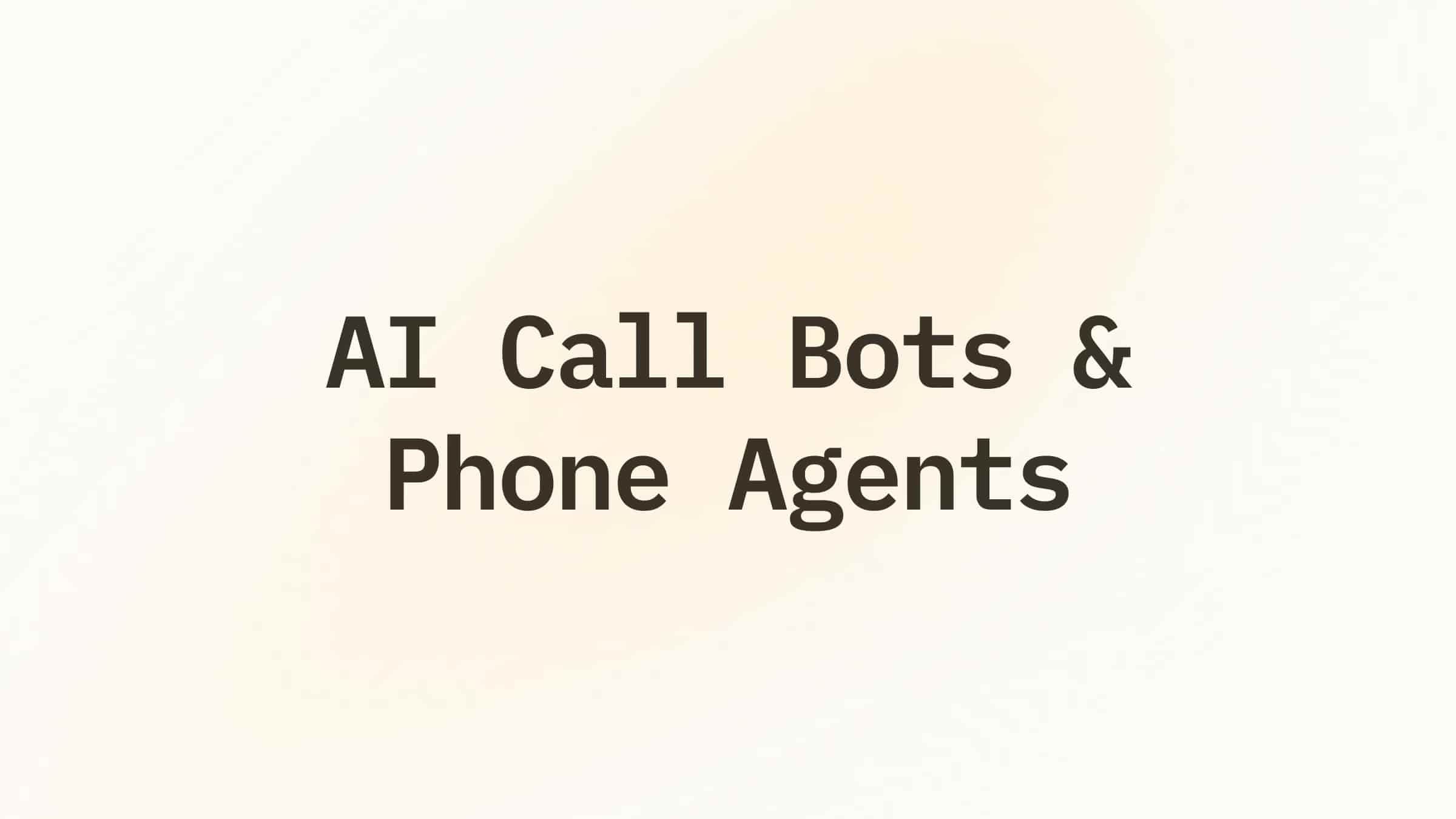Gumloop, Zapier, and Lindy all help teams automate work — but they’re built for very different types of users and workflows. Gumloop suits advanced AI workflows, Zapier handles beginner-friendly automations, and Lindy helps you build AI automations.
In this guide, you’ll learn:
- Quick comparison of the tools
- Reviews of each platform with its pros, cons, and pricing
- Which features matter most based on how technical your team is
- Who should pick which tool — and why
Let's start with a quick comparison table.
Gumloop vs Zapier vs Lindy: Quick comparison table
We compared Gumloop, Zapier, and Lindy based on core focus, how flexible they are, and where they might fall short. Here’s a quick side-by-side table:
Gumloop

Gumloop is a no-code automation tool that gives you a flexible canvas to build workflows using modular nodes, whether you’re scraping websites, summarizing data, processing documents, or routing tasks with conditions.
It's built for teams that want control and who work with more complicated workflows that most automation tools can't handle out of the box.
Features
- Canvas-based flow builder with support for loops, branching, subflows, and conditions.
- AI-native nodes for summarization, classification, sentiment analysis, and text transformation using models like GPT-4, Claude, or Gemini.
- Built-in web scraper with Chrome extension support for browser-based workflows.
- Automation document processing, ingest PDFs or emails, extract and format data using AI.
- Wrap workflows into simple front-end forms or internal tools.
- Supports Python/JavaScript nodes and webhook triggers for edge cases.
Pricing
Gumloop follows a credit-based pricing model, where each node, task, or AI call uses a set number of credits depending on how complex the workflow is. Here's what Gumloop’s price looks like:
Ideal for
- Technical teams running scraping, SEO, or lead-gen automations
- Ops managers automating internal document or ticket workflows
- Agencies delivering custom data workflows to clients
- Anyone outgrowing Zapier's limitations and willing to learn something more powerful
Pros
- One of the most flexible no-code builders available today
- Support for AI and unstructured data workflows
- Shareable interfaces make it usable across teams
Cons
- Steep learning curve if you're not used to visual automation tools
- Few prebuilt templates or beginner onboarding flows
- Price can spike with high-volume AI use
- Smaller integration library compared to Zapier
Zapier

Zapier is a widely used platform for no-code automation. It connects more than 7,000 apps and makes it easy to build workflows without touching code. The setup is fast, the UI is familiar, and it's built for people who want to move data between tools without worrying about infrastructure or syntax.
It's great for simple, repeatable automations. But once your workflows need AI, branching logic, or more custom logic than "if this, then that," Zapier starts to feel limiting.
Features
- Trigger → Action workflows with filters, delays, paths, and scheduling
- 7,000+ app integrations
- Zapier Tables, an internal spreadsheet-style database for lightweight data handling
- Zapier Interfaces, forms and dashboards connected to workflows
- Paths for conditional branching (Pro plan and up)
- OpenAI support through integration, not natively embedded into the platform
Pricing
Zapier charges per task, meaning each trigger or step run counts. Here’s a pricing breakdown:
The pricing can quickly increase for growing teams, especially if you're running frequent or multi-step automations.
Ideal for
- Small teams that want to move data between apps
- Non-technical users automating repetitive admin tasks
- Solopreneurs or marketers who want to build automations without touching APIs
Pros
- Easiest automation platform to start with
- Massive integration library — works with almost every popular tool
- Well-documented and well-supported, with a big community
Cons
- Limited logic
- Weak native AI support
- Zapier's cost scales poorly for multi-step workflows
- No scraping, no data cleanup, no flexible branching like in tools built for AI
Lindy

Lindy is an AI automation platform that lets you build customizable agents to handle tasks across email, CRM, voice, and more. You can add a knowledge base for these agents and prompt them so that they can understand context and take action.
With hundreds of prebuilt templates and a large integration library, it's designed for teams that want to automate workflows for better speed and efficiency using AI.
Features
- Drag-and-drop, no-code workflow builder for automations with logic, conditions, and triggers
- Multichannel support: works across email, phone, Slack, CRM, calendar, and more
- AI-native: supports GPT-4, Claude, Gemini, and others — with prompt-level control
- Prebuilt templates for use cases like follow-up emails, lead enrichment, scheduling, or admin ops
- Human-in-the-loop: Add confirmations, feedback, or manual overrides inside any flow
- 2500+ integrations via Pipedream partnership and also native integrations like Gmail, Outlook, Google Calendar, HubSpot, Salesforce, Notion, and more
- APIs and webhook support for custom integrations
Pricing
Lindy uses a credit-based model where credits are consumed per task, AI call, or voice interaction. Let’s have a look at all the plans:
Ideal for
- Sales teams running outbound and follow-up workflows
- Ops and admin leads automating meetings, approvals, and recurring tasks
- Support teams triaging emails or coordinating across tools
- Startups that want agents to "own" parts of a process, not just trigger steps
Pros
- Purpose-built for multi-step, AI-heavy workflows
- Drag-and-drop builder that supports logic, memory, and conditionals
- Supports email and CRM workflows out of the box
- Voice automation is available on paid plans, with more advanced call handling features unlocked at higher tiers
- Prebuilt templates and ability to add your knowledge base reduce setup time
Cons
- Integration catalog still smaller than Zapier
- Handles basic automations like email and meeting workflows well — but may be more than you need if you’re not looking to automate beyond those use cases.
Now that we know these tools, we’ll help you choose the right one for your use cases.
{{templates}}
Which should you choose?
Some teams need AI to handle complex logic across tools. Others want to move data from one app to another without touching code. Here's how it breaks down:
- If you're starting with simple automation: Go with Zapier. It's the easiest to set up and works with nearly every SaaS tool. It's perfect if your needs are straightforward, like sending form responses to Slack or copying data from Google Sheets to Notion.
- If you're working with web data, content pipelines, or custom logic: Gumloop is a better fit. It's designed for teams that need more than triggers and actions, especially if you're scraping content, enriching leads, or building branching flows with AI in the loop.
- If you want AI agents to automate tasks or parts of workflows: Lindy is worth looking at. It's best when the goal isn't just automation but delegation — having agents who can automatically read emails, respond, schedule, and loop in your tools. This is especially helpful for sales, support, or internal ops.
Each tool has its ceiling. The key is knowing how far your workflows need to scale.
{{cta}}
Frequently asked questions
What's the biggest difference between Gumloop and Zapier?
Gumloop is built for more complex workflows. Zapier, on the other hand, is better for basic app-to-app automation. If you're automating everyday SaaS tasks, Zapier is easier. If you're building workflows with complex branching logic or LLMs, Gumloop gives you more control.
Which is better for startups: Lindy or Gumloop?
It depends on the startup and what its applications are. If you're a sales team and want AI to handle outreach, scheduling, or CRM updates, Lindy gives you quick set up and efficiency. If you're more technical and need to automate research or technical workflows, Gumloop is more flexible.
How much does Zapier cost long-term?
You can save on Zapier’s long-term cost by choosing the annual plan — pricing starts at $19.99/month for the Professional plan (750 tasks), compared to $29.99/month when billed monthly.
Can I use AI in Zapier?
Zapier now offers native AI integrations and built-in AI actions. You can connect tools like OpenAI or Claude, generate text responses, summarize data, or trigger automations based on AI-generated content directly within your Zaps.
Is Gumloop better for AI apps or workflows?
Yes. Gumloop has AI nodes baked into the product for text summarization, classification, enrichment, and more. You can use GPT, Claude, or Gemini directly within flows, and shape the logic around their output.
Does Lindy replace Zapier or integrate with it?
Lindy is a strong Zapier alternative — especially if you’re building AI workflows with more steps. It’s better suited for use cases like lead follow-ups, meeting summaries, multi-channel outreach, and voice-based automations.
Is Lindy suitable for sales outreach?
Yes, that's one of its primary use cases. Lindy agents can find leads, enrich them from People Data Labs, send outreach emails, follow up, and handle responses. It works across email, voice, and CRM, and connects well with sales tools.
Can Gumloop integrate with CRMs like HubSpot?
Yes. Gumloop supports direct integrations with tools like HubSpot, Salesforce, Notion, and Airtable. If something is not natively supported, you can still connect via API or build a custom node.
Which has better customer support?
Zapier offers solid self-serve documents and email support. You can hire a Zapier expert too. Gumloop's paid Pro plan includes Slack support and faster response times. Lindy offers in-app AI chat, documentation, and agent setup guidance, plus access to Lindy Academy for walkthroughs and tutorials.
Try Lindy: A top alternative to Zapier or Gumloop
If you’re looking for an easy-to-use AI solution that provides automations around emails, meetings, sales, and more, go with Lindy.
Out of all the Zapier or Gumloop alternatives, here’s why Lindy stands out:
- Simple no-code interface: You won’t need coding, programming, or technical skills to create your automations with Lindy — it offers a drag-and-drop visual workflow builder.
- AI agents customized to your needs: You can make versatile AI agents that understand plain English and accelerate your productivity in many ways. For instance, create a Lindy that bolsters your sales funnel by finding leads from websites and business intelligence sources like People Data Labs. Then, make a Lindy that sends out emails to each lead and schedules meetings with members of your sales team.
- Affordability: Build your first few automations with Lindy’s free version and get up to 400 tasks. With the Pro plan, you can automate up to 5,000 tasks, which offers much more value than Lindy’s competitors.






















.jpg)
.png)
.png)


.png)
.png)